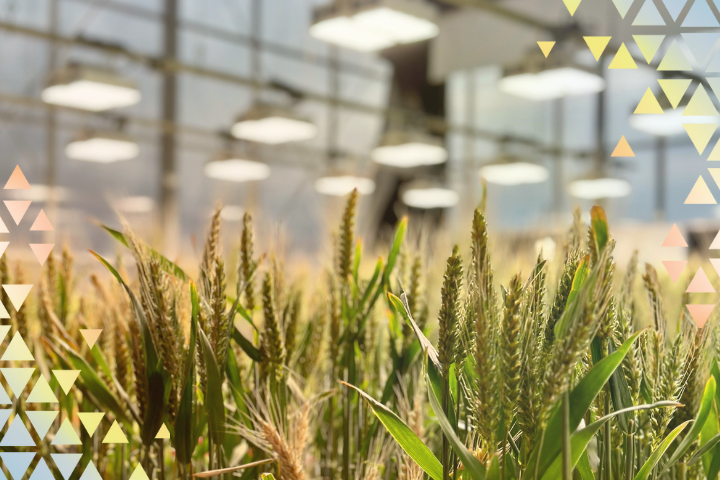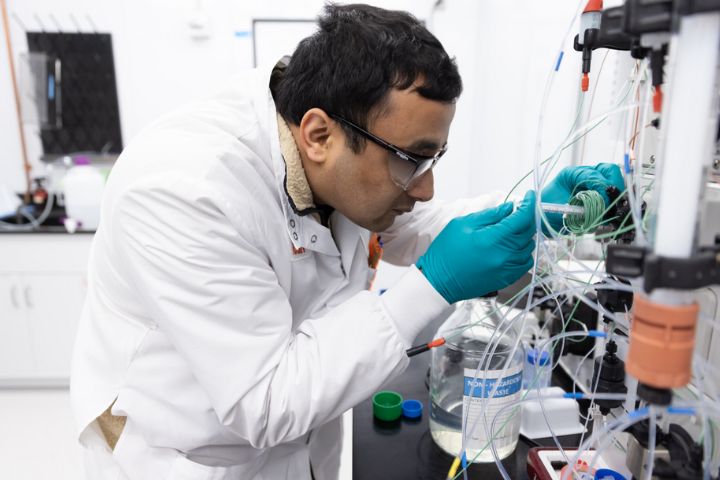Our mission at Inari – to help build a sustainable food system – is ambitious. But, we don’t lack confidence in our ability to complete it because as an organization, we’re relying on one of nature’s oldest and most effective strategies: diversity.
Nature doesn’t believe in doing things a single way. Neither do we.
By bringing together groundbreaking ideas from multiple disciplines, geographies and backgrounds, we’re constantly expanding our skill sets to push boundaries and, in turn, generate new solutions to some of humanity’s biggest challenges.
This diversity starts at the top, with a leadership team that’s more than 50% female – still a rarity in agriculture, technology and the C-suite in general. These leaders walked into Inari with their own unique experiences, but today they share a crucial commonality: our mission.
“I believe in the power of purpose, and mine has always been fairly simple,” says Chief Executive Officer Ponsi Trivisvavet. “I want to leave the world in a better place than I found it.”
Chief Scientific Officer Catherine Feuillet shares a similar perspective, adding that it takes intentional action to deliver on this promise.
“Many speak about the importance of diversity and multidisciplinary approaches for ‘disruptive innovation,’” Feuillet says. “Inari is the first time I’ve truly seen it happening.”
This firm commitment is attracting talent from across industries. Rania Khalaf, Inari’s Chief Information and Data Officer, arrived at the company not with an agricultural background, but after nearly two decades at IBM.
“I am continually impressed at the way Inari embraces thinkers from all disciplines,” Khalaf says. “It’s energizing to join forces with industry veterans and fellow newcomers to look at old problems through new lenses.”
Through this combined diversity, Inari is making scientific progress in directions previously thought unimaginable. That’s what most inspires Chief Product Officer Claudia Nari.
“Much of our work truly was impossible even just a decade ago. That’s how quickly our industry has changed and will continue to change,” Nari says. “Fortunately, with the diverse team of thought leaders we have at Inari, I’m confident we’ll help lead the way.”
Continue reading for more of our leaders’ perspectives.

‘Leave the World in a Better Place’
Ponsi Trivisvavet, Chief Executive Officer
I believe in the power of purpose, and mine has always been fairly simple: I want to leave the world in a better place than I found it. More so than at any other stop in my career, Inari offers that opportunity.
Our vision is bold, but in the face of a fast-changing climate, we also view it as a global imperative – not a “nice to have,” but a “must have.” Agriculture is the basis of food. Food is the basis of health. Health is the basis of security. If we want to maintain that security, our planet needs significant innovation now more than ever.
To tackle this challenge, we’ve brought together more than 180 of the brightest minds in data science and analysis, plant and human biology, agronomy, and software engineering. Applying an intersection of our disciplines, we’re challenging every single step of how current breeding is done, from seed product design to gene discovery to plant delivery.
The solutions resulting from our diverse approach are accelerating and bringing precision to nature’s innate processes, creating technology that has the power to transform any plant in any geography by unlocking the full potential of seed. Not only will we be able to increase production, but we’ll also be able to reduce the amount of land and other resources required. These are substantial, nature-positive developments.
Our teams are using some of the most advanced tools available today, combining predictive design and multiplex gene editing in our SEEDesignTM platform. But even as we marvel at the “what” of our work, it’s the “why” that keeps our diverse team together: a commitment to leaving the world in a better place than we found it.
–
‘The Right Team at the Right Time, Built for the Right Challenge’
Catherine Feuillet, Chief Scientific Officer
Many speak about the importance of diversity and multidisciplinary approaches for “disruptive innovation,” but Inari is the first time I’ve truly seen it happening. Our science team alone is something to behold, with an incredibly diverse set of backgrounds, including plant biology, genomics, cancer research, mathematics and physics, just to name a few.
I believe this is truly the right team at the right time, built for the right challenge. Pushing frontiers, achieving with a group of passionate people what others think is impossible but needs to be done, for an outcome that will impact so many people’s lives – that is our shared purpose. It’s also why I joined Inari and enjoy building it together every day.
In a career spanning both academic and corporate roles, one constant has been my desire to take on what others have called impossible but will provide value to breeders and farmers. Before joining Inari, I led the international effort to sequence the bread wheat genome (as founder and co-chair of the International Wheat Genome Sequencing Consortium, or IWGSC) and led the team at INRA (Institut National de la Recherche Agronomique) in France that first cracked the genetic code of the largest wheat chromosome – a chromosome that alone is as big as the soybean genome.
Many people did not believe we would succeed when we started the IWGSC, but we did. The same will be true here at Inari.
Our unique combination of predictive design and multiplex gene editing enables us to deal with the complexity of nature and eventually design the right seeds for the right environment, achieving our vision to have a nature-positive impact. The progress I’ve already seen within our walls is both promising and inspiring, and I can’t wait to share it with the world.
–
‘Data is the Backbone and the Directional Guide’
Rania Khalaf, Chief Information and Data Officer
The bold vision of positively impacting our planet is what first sparked my interest in Inari, but it was this organization’s inspired execution that made me take the leap to join.
I joined Inari from IBM, where I spent the last two decades leading innovation in artificial intelligence and cloud computing. Arriving without a background in agriculture, I am continually impressed at the way Inari embraces thinkers from all disciplines. It’s energizing to join forces with industry veterans and fellow newcomers to look at old problems through new lenses, thinking together about how to interleave data and computing with biological systems to help us move faster and with more accuracy in our journey toward better seeds for people and the planet.
Like it has been throughout my career, data is both the backbone and the directional guide for this organization. Each step of the Inari R&D process produces data, but this data – which ranges in type and complexity – only serves you if you know how to use it. What matters? What can we learn? What’s missing? Answering these questions is where our expertise in data and machine learning comes in. Parsing this fast-growing volume of information and mixing it in with public data in this domain can help us answer crucial questions like which genes to edit, which edits will have the biggest impact and which genetic lines are the most amenable to being edited.
Historically, scientists and breeders would have had to rely on time-consuming trial and error to test a hypothesis, wait for plants to grow and confirm they are headed in the right direction. Our aim is to largely put that in the past by using models and software that predict and simulate.
The latest advances in computer hardware, the availability of large genomic data sets and advances in algorithms are making it possible to use machine learning to drastically speed up breeding and editing pipelines. By running computer models of trials that would be otherwise impossible because of the vast amount of possible combinations, we are constantly enabling better decisions, better designs and more confidence in a new product’s performance in a fraction of the time.
Plus, thanks to the power of artificial intelligence, our systems – as well as all of us at Inari – will only continue to get faster and smarter.
–
‘Our Scientists Deliver Possibility; My Team Identifies Opportunity’
Claudia Nari, Chief Product Officer
I’ve been involved in breeding and product design long enough to have had a front row seat to some incredible innovations and transformations. None, however, have inspired me as much as the work we are tackling at Inari.
What our research and development teams are producing sometimes boggles my mind – not only because of their skills and accomplishments or the collaboration at all levels of the organization, but also because of the audacity of their mission. Agricultural experts have been confident since the discovery of gene editing that the technology could reshape the industry, but for a company to prioritize product edits that improve resource use efficiency in corn and soybeans is incredibly bold. That said, it is also incredibly important. Any technology that can improve the sustainability of a footprint as large as that of broadacre crops has the chance to deliver widespread positive change, which this industry and our planet desperately need.
The breeding techniques of the past 25 years have delivered on some impressive scientific feats, like widespread, previously unheard of herbicide tolerance. But drastic reductions in inputs, not to mention large-scale increases in yield potential, have remained stubbornly elusive. I believe our work at Inari will help to finally get agriculture and the planet over the hump.
In my role, I have the honor of leading the team that serves as the link between our R&D team’s capabilities and the product needs of farmers worldwide that will help reshape our food system. Our scientists deliver possibility; my team identifies opportunity. By closely linking with our commercial teams and fully exploring the data and information capabilities that technology offers us today, we’re working hard together to develop the best possible crops for the future.
Perhaps most inspiring about our work is that much of it truly was impossible even just a decade ago. That’s how quickly our industry has changed and will continue to change. Fortunately, with the diverse team of thought leaders we have at Inari, I’m confident we’ll help lead the way.
RELATED POSTS
Three Ways Gene Editing Supports Biodiversity
Genetic diversity in plants is the foundation of resilience, productivity, and adaptability. It enables crops to withstand environmental pressures, resist diseases, and thrive in varying climates, the result of millennia…
Inari’s Labs Achieve ‘My Green Lab’ Certification
We have a deep commitment at Inari to food system sustainability, which in addition to prioritizing food security and improved farmer well-being puts a focus on better caring for our…
An October Reflection on Food System Sustainability
By Jamie SaxonHead of Sustainability – Harvest season is in full swing in the U.S., a time of year that’s equal parts exciting, nerve-wracking and busy for farmers as they…


